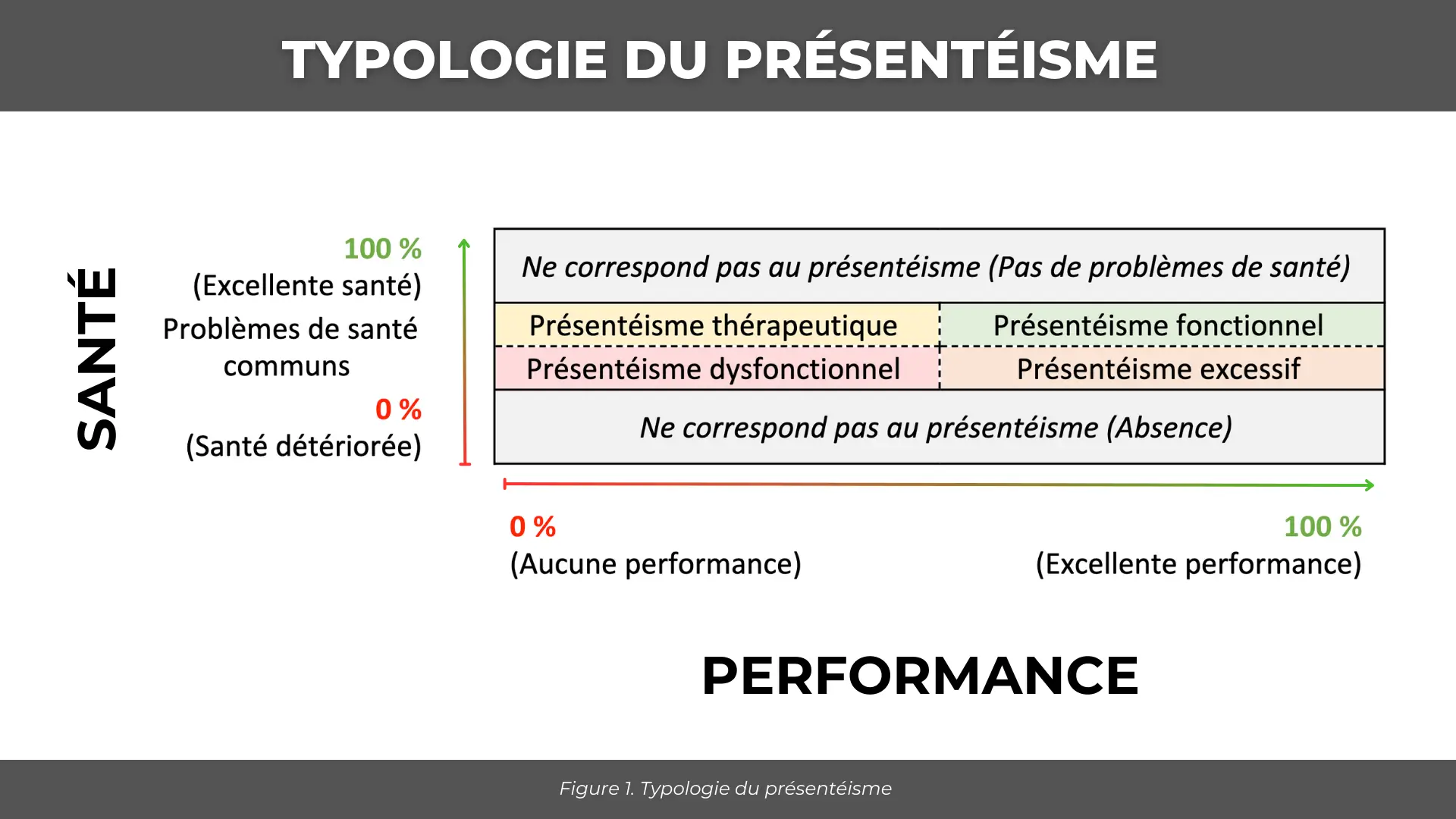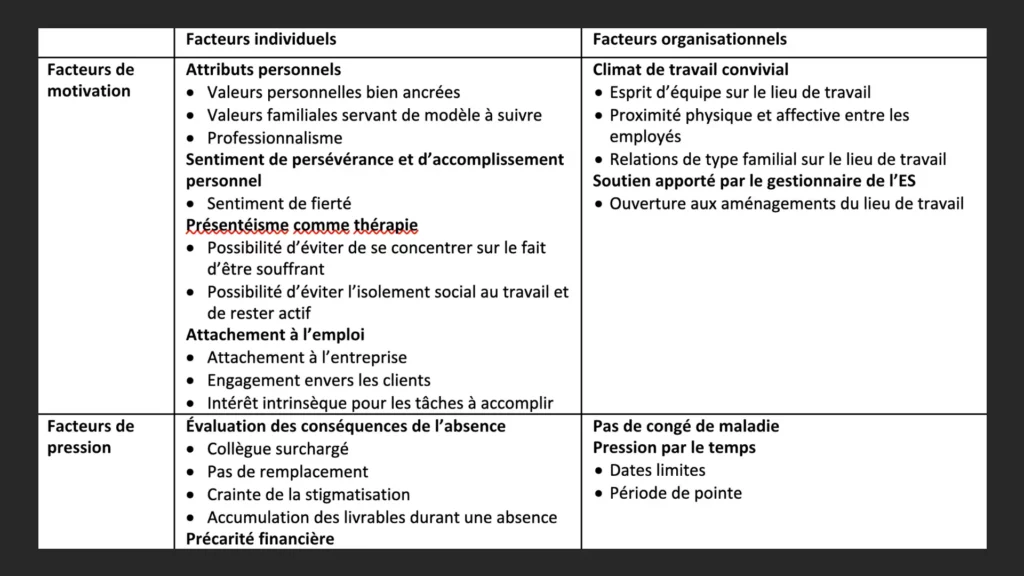Article written by Lukas Monfette, Human Resources Consultant and Call & Response Coordinator at Brio PAE
Have you ever come to work knowing full well that you wouldn’t be able to give your best to get the job done? Perhaps you had a cold or were preoccupied with a personal problem? If your answer is yes, you are or have been a presentationist. Be aware that this is a normalized and widespread behavior that can have unsuspected impacts.
With this article, we want to raise awareness about presenteeism and help you understand whether your presence at work (physical or virtual) is always the best choice compared to absence, for both you and your employer.
Definition
When problems arise2 physical or psychological health problems, you have the choice of being present at work or missing work. The first alternative describes presenteeism, i.e. working despite health problems. The second refers to sick leave (hereinafter referred to as absenteeism). ), or not showing up to work for health reasons. Simply put, these behaviours are complementary rather than independent (Gosselin and Lauzier, 2011).
Examples of symptoms
- Physical health: Headache,backache,cold or flu,seasonal allergy,digestive or intestinal problems, etc.
- Psychological health: Distress or anxiety, tensions in relationships, financial stress, deuil, fatigue mentale, etc.
How to choose?
Presenteeism is a resilient behavior. You choose to adapt to the situation (health problem) in order to achieve a goal (for example, accomplishing your work tasks within the allotted time). In other words, you try to balance your health and your performance. However, this choice is not always the most appropriate in the long term.
Indeed, “taking time off can serve to prevent a deterioration in health, reduce tensions or recover from an uncomfortable situation and thus promote future presence” (Foucher, 2019).
Consider the type of presenteeism and your current situation
Absenteeism and several types of presenteeism coexist in everyday organizational life. According to the model proposed by Karanika-Murray and Biron (2020), there are four types of presenteeism that you need to be aware of in order to make the right decisions for your health and performance at work (see Figure 1):

Functional presenteeism: You are attentive to your health. At the same time, you adapt to the availability of your capacities in order to maintain a sufficient level of performance.
TIP: Functional presenteeism should be preferred to absenteeism, as it allows you to feel good while working in a reasonable way.
Therapeutic presenteeism: You show up for work because it makes you feel better, even though you recognize that your productivity is significantly reduced.
TIP: Therapeutic presenteeism should be preferred to absenteeism, especially in isolated situations. However, you should talk to your superiors about a temporary assignment.
Excessive presenteeism: You put your health on the back burner to deliver high performance.
TIP: For more than a few days, absenteeism should be preferred to excessive presenteeism, as you run the risk of aggravating your symptoms. This is a very short-term solution.
Dysfunctional presenteeism: You show up for work even though this behavior has no positive effects on your health, while at the same time being unable to deliver a sufficient level of performance.
TIP: Absenteeism should be preferred to dysfunctional presenteeism, as your reputation and working relationships could be affected.
Consider the factors that influence you
Many individual and organizational factors can influence this choice, making each situation unique in terms of motivations and pressures.
That said, the statistics show widespread concerns: “More than half (54%) of respondents do so because they feel they have too much work to do, and 33% don’t want to use a sick day.”
Reviewing this with your manager can help you put adaptive measures in place. We invite you to take a look at Table 1.
Consider the network around you
Presenteeism allows your colleagues or employer to notice an improvement or deterioration in your health.
On the one hand, physical signs (tired face, loss of smile), cognitive signs (lack of concentration) or psychological signs (negative attitude, passivity) may show up in your regular interactions (physical or virtual) with members of your organization, enabling you to address them.
On the other hand, being involved in day-to-day work, changes (voluntary or otherwise) to your behaviours, normal habits and productivity may be perceived. For example, others may detect your tendency to compensate by arriving earlier, minimizing your breaks or staying a little longer at work, or to slow down your pace by performing tasks more slowly, extending your breaks or pushing back deadlines.
In comparison, absenteeism offers a limited window of opportunity to observe your health problem. It often falls to one person to follow up with you when you’re away.

How to maintain a beneficial presenteeism?
On an individual level, the solution is clear: you need to talk to your managers or your human resources department about your needs.. By opting for a transparent conversation, your managers will be able to support you and adapt performance expectations (e.g.: temporary reduction in hours, adjustment of work schedule, temporary reduction in workload). The Mental Health Commission of Canada reports that nearly 60% of people with symptoms of psychological distress will not seek help for fear of being stigmatized. . If you have any doubts, it’s important to point them out and challenge the confidentiality and repercussions of your sharing.
On an organizational level, you need to aim to establish and maintain a caring culture. Your organization’s representatives must demonstrate a concern for health on a par with productivity. The first change should be to get managers to set an example by applying the advice in this article for themselves.
Conclusion
Absenteeism and presenteeism will remain unavoidable phenomena in organizations, because each has a distinct function. That’s why it’s important to consider presenteeism as a complementary alternative to absenteeism. To do this, you need to consider the aspects and consequences of presenteeism on your health and performance. It would be wrong to think that it’s always better to show up for work. To help you think about this, and to encourage conversation with your employer, here are a few points to consider. relevant questions to ask yourself:
- Does my work have a positive effect on my well-being (for example, does it give me a sense of satisfaction, fulfillment or belonging)?
- Is my recovery significantly slowed by my presence at work?
- Is my productivity enough to justify my salary?
- Can I transmit a contagious disease to my colleagues at work?
- Can I postpone some less urgent or less important tasks?
- Does my work offer me support resources to help me through this difficult period?
By reflecting on these questions, you can determine the tipping point that applies to your reality.At Brio PAE, we’re convinced that your health and well-being as employees must be the top priority in this choice.
